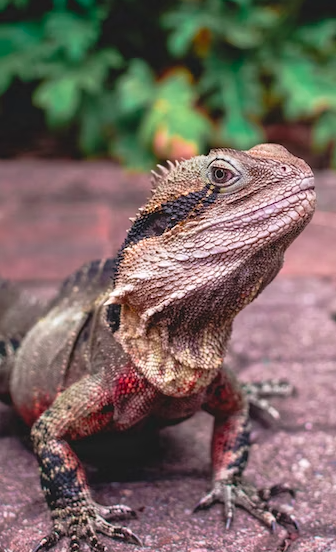Bearded Dragon Behavior Training: Do Bearded Dragons Bite?
As a passionate bearded dragon enthusiast and advisor, I often come across the question, “Do bearded dragons bite?”
It’s a valid concern for prospective and current owners alike. In this article, we’ll explore the biting behavior of bearded dragons, understand the factors influencing it, and provide helpful suggestions for preventing and addressing biting incidents.
Understanding Bearded Dragon Behavior
Before diving into the biting behavior, it’s essential to understand the natural instincts and defensive mechanisms of bearded dragons. These reptiles are generally docile and make wonderful pets, but they still possess certain behaviors that are part of their evolutionary makeup.
Factors Influencing Whether Bearded Dragons Bite
Various factors can influence whether bearded dragons bite. Understanding these factors can help us address the underlying causes and minimize the occurrence of biting incidents. Age, handling techniques, stress levels, and territoriality are among the key factors to consider.
-Age: Bearded dragons go through different developmental stages, and their behavior can vary accordingly. Juvenile dragons are more likely to exhibit defensive behaviors, including biting, as they are still learning about their environment and establishing boundaries. With proper socialization and training, biting tendencies can decrease as they mature.
-Handling Techniques: Improper handling techniques can cause stress and discomfort in bearded dragons, leading to defensive behavior such as biting. Rough handling, sudden movements, or grabbing them by the tail can trigger their natural instincts to defend themselves. It is essential to handle them gently and support their body to make them feel secure.
-Stress Levels: Bearded dragons, like any other living beings, can experience stress. Factors such as inadequate enclosure size, improper temperature and lighting, loud noises, or frequent disturbances can contribute to increased stress levels. When stressed, bearded dragons may become more prone to defensive behaviors, including biting. Creating a calm and comfortable environment is crucial to minimizing stress and reducing biting incidents.
-Territoriality: Bearded dragons are territorial creatures, especially males. They may display aggressive behaviors, including biting, to protect their territory or assert dominance. This behavior is more common during the breeding season or when introduced to unfamiliar bearded dragons. Properly managing their living space and providing adequate socialization can help mitigate territorial aggression.
-Previous Negative Experiences: Bearded dragons have memories, and negative experiences can shape their behavior. If a bearded dragon has had traumatic encounters or painful incidents in the past, they may develop fear or aggression, leading to biting as a defensive response. Building trust and positive associations through gentle handling and positive reinforcement training can help overcome these negative experiences.
-Health Issues: Sometimes, underlying health problems can contribute to changes in behavior, including biting. If a bearded dragon is experiencing discomfort or pain due to illness, injury, or an untreated health condition, they may become more defensive and exhibit biting behavior. Regular veterinary check-ups and prompt medical attention can help address potential health issues, maximize the bearded dragons lifespan, and minimize the risk of biting.
By considering these factors and addressing them proactively, you can create a safe and comfortable environment for your bearded dragon, reducing the likelihood of biting incidents. Remember, patience, consistent training, and positive reinforcement are key to building trust and fostering a harmonious relationship with your pet.
Preventing Biting Incidents
Prevention is always better than cure when it comes to biting incidents. By following proper handling techniques and socializing your bearded dragon from a young age, you can significantly reduce the likelihood of biting. We’ll discuss practical strategies and tips for preventing biting incidents.
Recognizing Warning Signs
Bearded dragons have their unique ways of communicating, and it’s crucial to recognize the warning signs they exhibit when they feel threatened or uncomfortable. These signs can warn someone before bearded dragons bite. Understanding their body language and communication cues can help us respond appropriately and prevent escalation.
-Body Language: Pay close attention to your bearded dragon’s body language. If they feel threatened or uncomfortable, they may display certain behaviors as warning signs. These can include puffing up their beard, hissing, flattening their body, or displaying aggressive postures like arching their back and opening their mouth wide. These are clear indications that they are feeling defensive and may resort to biting if the perceived threat continues.
-Tail Movements: The movement of the tail can provide valuable insights into your bearded dragon’s emotional state. A calm and relaxed bearded dragon typically holds its tail in a neutral position or gently sways it from side to side. However, if the tail starts twitching rapidly or whipping back and forth, it may indicate agitation or annoyance. This can be a precursor to defensive behavior, including biting.
-Eye Contact: Bearded dragons have expressive eyes, and their gaze can communicate a lot about their mood. If your bearded dragon maintains direct eye contact, especially with dilated pupils or a fixed stare, it could be a sign of unease or aggression. Avoid prolonged eye contact in such situations, as it may escalate their defensive response.
-Vocalizations: While bearded dragons are not known for vocalizations like barking or growling, they can make distinct hissing sounds when they feel threatened. If your bearded dragon starts hissing, it’s a clear warning sign that they are uncomfortable or feeling defensive. Take this as an opportunity to remove the source of stress and create a more secure environment for your pet.
-Agitated Behavior: Restlessness, pacing, or trying to hide are indications that something is amiss. Bearded dragons may display these behaviors when they are feeling anxious or stressed. If you observe such behavior, it’s important to assess the situation and identify potential triggers, such as excessive noise, extreme temperatures, or overcrowded living spaces.
-Sudden Changes in Behavior: Pay attention to any sudden changes in your bearded dragon’s behavior. If they were previously docile and suddenly become more aggressive or defensive, it could be a sign of underlying discomfort or distress. Monitor their eating habits, activity levels, and overall demeanor for any noticeable changes that could be indicative of an issue.
Recognizing these warning signs allows you to adjust your approach and minimize the risk of a biting incident. By providing a calm, secure, and well-maintained environment, addressing any potential stressors, and respecting your bearded dragon’s boundaries, you can foster a positive relationship and reduce the likelihood of bites. Remember, each bearded dragon is unique, so it’s important to observe and understand your individual pet’s behavior and preferences.
Responding to Biting Incidents
Despite our best efforts, biting incidents may still occur. It’s essential to know how to respond safely and effectively if your bearded dragon bites. We’ll provide guidance on handling bites, ensuring your safety and minimizing stress for both you and your pet.
Training and Taming Bearded Dragons
Training and taming your bearded dragon are an essential part of building a strong bond and establishing a trusting relationship. While they may not be as trainable as dogs, bearded dragons are intelligent creatures capable of learning and responding to positive reinforcement. Here are some key points to consider when it comes to training and taming your bearded dragon:
-Start Early: It’s best to begin the training and taming process as early as possible, preferably when your bearded dragon is still a baby. Younger dragons tend to be more receptive and adaptable to new experiences. This early exposure helps them become accustomed to human interaction and handling.
-Create a Comfortable Environment: Before starting any training, ensure that your bearded dragon’s enclosure is set up correctly. Provide a spacious, well-heated, and properly lit habitat with hiding spots, climbing structures, and appropriate substrates. A comfortable and secure environment will make your dragon feel safe and more receptive to training.
-Gradual Socialization: Introduce your bearded dragon to human presence gradually. Start by simply sitting near the enclosure, talking softly, and offering treats without direct contact. Over time, progress to gently placing your hand inside the enclosure for short periods. Allow your bearded dragon to approach and explore your hand at their own pace.
-Positive Reinforcement: Bearded dragons respond well to positive reinforcement techniques. Use rewards such as small, healthy treats or favorite foods to motivate and reward desired behavior. For example, offer a treat when your dragon willingly climbs onto your hand or remains calm during handling. This positive association helps reinforce good behavior and strengthens the bond between you and your dragon.
-Gentle Handling: When handling your bearded dragon, always be gentle and avoid sudden movements. Support their body properly, ensuring that their limbs and tail are fully supported to prevent any discomfort or stress. Start with short handling sessions and gradually increase the duration as your dragon becomes more comfortable.
-Habituation to Touch: As part of taming, gradually introduce your bearded dragon to touch. Start by lightly stroking their back or head, and gradually move to areas such as the tail and limbs. Observe their response and adjust the intensity and duration of touch based on their comfort level.
-Consistency and Patience: Training and taming require patience and consistency. Work with your bearded dragon regularly, but keep sessions short and positive. Respect their boundaries and never force them into situations they’re uncomfortable with. Each dragon has its own personality and may progress at a different pace, so be patient and understanding.
-Avoid Punishment: Punishment or harsh methods should never be used when training or taming your bearded dragon. They respond much better to positive reinforcement and gentle encouragement. Punishment can cause fear and stress, damaging the trust you are trying to build with your pet.
-Seek Professional Guidance: If you encounter challenges or need additional guidance, consider consulting a reptile veterinarian or a qualified reptile behaviorist. They can provide valuable insights and personalized advice based on their expertise.
Remember, training and taming take time and effort. Be patient, consistent, and understanding with your bearded dragon. Through positive reinforcement, gentle handling, and a nurturing environment, you can develop a strong and trusting relationship with your reptile companion.
Do Baby Dragons Bite Conclusion
In conclusion, the question “Do bearded dragons bite?” can be addressed with a nuanced understanding of their behavior and proactive measures to prevent and address biting incidents. By following the suggestions and tips provided in this article, you can create a harmonious and enjoyable bond with your bearded dragon.
FAQs
- Are all bearded dragons prone to biting? Bearded dragons have different personalities, and while biting incidents can occur, not all bearded dragons are prone to biting. Proper handling, socialization, and training can help minimize biting behavior.
- Can I train my bearded dragon not to bite? Yes, bearded dragons can be trained to reduce biting tendencies. Patient and consistent training, along with positive reinforcement, can help modify their behavior and foster a trusting bond.
- What are the signs that my bearded dragon is feeling threatened? Signs of stress or feeling threatened include puffing up their beard, hissing, flattening their body, or displaying aggressive body language




